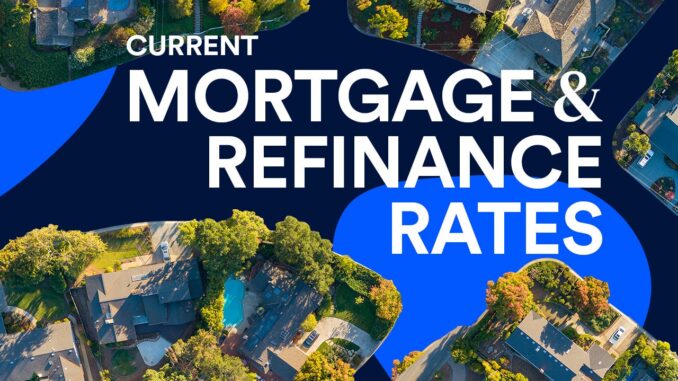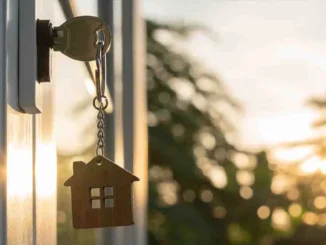
Mortgage interest rates were mostly down compared to a week ago, according to data compiled by Bankrate. Rates for 30-year fixed, 5/1 ARMs and jumbo loans decreased, while rates for 15-year fixed mortgages rose.
The Federal Reserve has raised rates 10 times in a row, most recently at its May 3 meeting. Rates now are at a 15-year high, but the consensus is that inflation is finally cooling and the central bank might halt raising rates.
”Mortgage rates have settled into a new normal of around 6.5 percent on a 30-year fixed-rate loan,” says Lisa Sturtevant, chief economist at Bright MLS, a large multiple listing service in the Middle Atlantic region. ”With growing recession risks, we could see mortgage rates dip lower, but we will not be returning to the 3 percent level seen during the height of the pandemic.”
| Loan term | Today’s Rate | Last week | Change |
|---|---|---|---|
| 30-year mortgage rate | 6.83% | 6.85% | -0.02 |
| 15-year mortgage rate | 6.23% | 6.17% | +0.06 |
| 5/1 ARM mortgage rate | 5.79% | 5.80% | -0.01 |
| 30-year jumbo mortgage rate | 6.88% | 6.92% | -0.04 |
Rates accurate as of May 8, 2023.
These rates are averages based on the assumptions shown here. Actual rates available on-site may vary. This story has been reviewed by Suzanne De Vita. All rate data accurate as of Monday, May 8th, 2023 at 7:30 a.m.
You can save thousands of dollars over the life of your mortgage by getting at least three rate quotes. Comparing mortgage offers from multiple lenders is always a smart move, but shopping around grew especially critical during the interest rate run-up of 2022, according to research by mortgage giant Freddie Mac. It found the payoff for bargain-huntng borrowers doubled last year.
“All too often, some homeowners take the path of least resistance when seeking a mortgage, in part because the process of buying a home can be stressful, complicated and time-consuming,” says Mark Hamrick, senior economic analyst for Bankrate. “But when we’re talking about the potential of saving a lot of money, seeking the best deal on a mortgage has an excellent return on investment. Why leave that money on the table when all it takes is a bit more effort to shop around for the best rate, or lowest cost, on a mortgage?”
Mortgage interest rates
30-year fixed-rate mortgage trends down, -0.02%
The average rate for the benchmark 30-year fixed mortgage is 6.83 percent, down 2 basis points over the last seven days. A month ago, the average rate on a 30-year fixed mortgage was higher, at 6.87 percent.
At the current average rate, you’ll pay a combined $653.92 per month in principal and interest for every $100,000 you borrow. That’s $1.34 lower, compared with last week.
30-year mortgage vs. 15-year mortgage
Standard lending practices defer to the 30-year, fixed-rate mortgage as the go-to for most borrowers buying a home because it allows the borrower to scatter mortgage payments out over 30 years, keeping their monthly payment lower.
With a 15-year mortgage, however, borrowers are able to pay off their loan in half the time — if they’re able and willing to expand the amount of their monthly loan payment. The primary difference between qualifying for a 15-year versus a 30-year mortgage is that you’ll need a higher income and lower debt-to-income (DTI) ratio to obtain a 15-year mortgage because the monthly payments are loftier.
15-year mortgage rate increases,+0.06%
The average rate for the benchmark 15-year fixed mortgage is 6.23 percent, up 6 basis points from a week ago.
Monthly payments on a 15-year fixed mortgage at that rate will cost around $856 per $100,000 borrowed. That may put more pressure on your monthly budget than a 30-year mortgage would, but it comes with some big advantages: You’ll come out several thousand dollars ahead over the life of the loan in total interest paid and build equity much faster.
5/1 adjustable rate mortgage trends down, -0.01%
The average rate on a 5/1 adjustable rate mortgage is 5.79 percent, falling 1 basis point over the last 7 days.
Adjustable-rate mortgages, or ARMs, are mortgage loans that come with a floating interest rate. To put it another way, the interest rate can change intermittently throughout the life of the loan, unlike fixed-rate mortgages. These loan types are best for people who expect to sell or refinance before the first or second adjustment. Rates could be considerably higher when the loan first adjusts, and thereafter.
While borrowers shunned ARMs during the pandemic days of super-low rates, this type of loan has made a comeback as mortgage rates have risen.
Monthly payments on a 5/1 ARM at 5.79 percent would cost about $586 for each $100,000 borrowed over the initial five years, but could increase by hundreds of dollars afterward, depending on the loan’s terms.
Jumbo mortgage interest rate moves lower, -0.04%
The average jumbo mortgage rate today is 6.88 percent, a decrease of 4 basis points from a week ago. A month ago, the average rate for jumbo mortgages was higher, at 6.94 percent.
At today’s average jumbo rate, you’ll pay principal and interest of $657.26 for every $100,000 you borrow. That’s $2.68 lower, compared with last week.
In summary: How interest rates have changed this week
- 30-year fixed mortgage rate: 6.83%, down from 6.85% last week, -0.02
- 15-year fixed mortgage rate: 6.23%, up from 6.17% last week, +0.06
- 5/1 ARM mortgage rate: 5.79%, down from 5.80% last week, -0.01
- Jumbo mortgage rate: 6.88%, down from 6.92% last week, -0.04
Refinance rates
Today’s 30-year mortgage refinance rate eases, –0.04%
The average 30-year fixed-refinance rate is 6.96 percent, down 4 basis points since the same time last week. A month ago, the average rate on a 30-year fixed refinance was higher, at 6.98 percent.
At the current average rate, you’ll pay $662.62 per month in principal and interest for every $100,000 you borrow. Compared with last week, that’s $2.68 lower.
Where are mortgage rates headed?
The days of sub-3 percent mortgage interest on the 30-year fixed are behind us, and rates have so far risen beyond 7 percent in 2022.
“Low interest rates were the medicine for economic recovery following the financial crisis, but it was a slow recovery so rates never went up very far,” says McBride. “The rebound in the economy, and especially inflation, in the late pandemic stages has been very pronounced, and we now have a backdrop of mortgage rates rising at the fastest pace in decades.”
Comparing different mortgage terms
The 30-year fixed mortgage is the most popular loan for homeowners. This type of loan has a number of advantages, including:
- Lower monthly payment: Compared to a shorter term, such as 15 years, the 30-year mortgage offers lower payments spread over time.
- Stability: With a 30-year mortgage, you lock in a consistent principal and interest payment. Because of the predictability, you can plan your housing expenses for the long term. Remember: Your monthly housing payment can change if your homeowners insurance and property taxes go up or, less likely, down.
- Buying power: With lower payments, you can qualify for a larger loan amount and a more expensive home.
- Flexibility: Lower monthly payments can free up some of your monthly budget for other goals, like saving for emergencies, retirement, college tuition or home repairs and maintenance.
- Strategic use of debt: Some argue that Americans focus too much on paying down their mortgages rather than adding to their retirement accounts. A 30-year fixed mortgage with a smaller monthly payment can allow you to save more for retirement.
That said, shorter-term loans have gained popularity as rates have been historically low. Although they have higher monthly payments compared to 30-year mortgages, there are some big benefits if you can afford the upfront costs. Shorter-term loans can help you achieve:
- Greatly reduced interest costs: Because you pay off the loan faster, you’ll be able to pay less interest overall.
- Lower interest rate: On top of less time for that interest to compound, most lenders price shorter-term mortgages with lower rates.
- Build equity faster: The faster you pay off your mortgage, the faster you’ll own value in your home outright. That’s especially handy if you want to borrow against your property to fund other spending.
- Debt-free sooner: A shorter-term mortgage means you’ll own your house free and clear sooner than you would with a longer-term loan.
Is now a good time to buy a house?
There’s never a straightforward answer to this question. It always depends. Do you have a reliable income, a good credit score and money saved for a down payment and repairs? If you can answer all of those questions affirmatively, you’re ready to buy.
However, the pandemic has led to an even greater shortage of homes. That’s caused a bidding war and rising prices. Those trends mean it can be a frustrating market for buyers.
Source:
ENB
Sandstone Group



